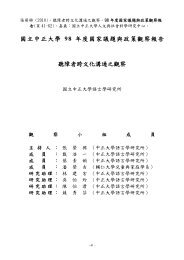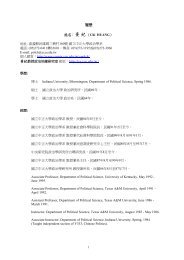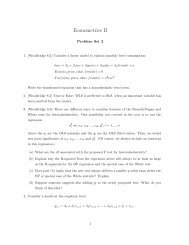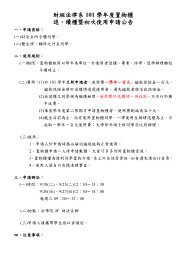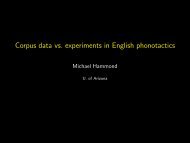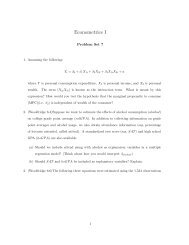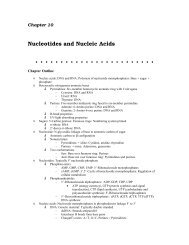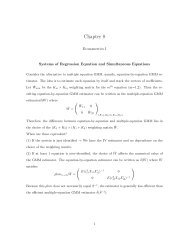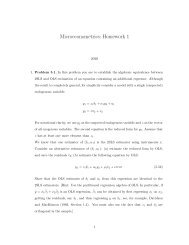Slides
Slides
Slides
You also want an ePaper? Increase the reach of your titles
YUMPU automatically turns print PDFs into web optimized ePapers that Google loves.
A study of 6 English-speaking children aged between 2 years and 2 years 5 months,<br />
with MLU ranging from 2.93 to 4.14.<br />
Example 2: Modal auxiliaries in English (Valian 1991)<br />
A study of 21 American children aged between 1;10 and 2;8, divided into 4 age<br />
groups, the youngest group having the mean age of 2;0 and mean MLU 1.77, and the<br />
oldest group having the mean age of 2;7 and MLU 4.22.<br />
All children except the lowest MLU child produced modal auxiliaries. In every group,<br />
'can' and 'll/will' were the two most common modals.<br />
Modal usage was infrequent: in Group I, only 3% of utterances with verbs contained<br />
modals, a total of 14 tokens. There was a steady gradual increase to 6% in Group II<br />
(61 tokens), 9% in Group III, and 14% in Group IV.<br />
Valian argued that Group I children have knowledge of modals as a category separate<br />
from verbs, ie. knowledge of INFL.<br />
"First appearance correlates highly with more stringent criteria...Sampling<br />
considerations alone would suggest that a child has been using a form before our data<br />
demonstrate it. ....At present any criterion beyond initial correct use appears arbitrary.<br />
Since the Group I children made no distributional errors with the modals they used,<br />
we have called their use genuine." (p. 60)<br />
Example 3: Finite vs nonfinite distinction of verbs in Dutch<br />
Table 2. Verb use by Dutch children (aged 1;7-3;7; N=47) (Wexler 2003)<br />
All normal children V2 Vfinal<br />
Finite 1953 (99%) 11 (2%)<br />
Non-finite 20 (1%) 606 (98%)<br />
"Very little leeway has to be given to measurement error or noise, even at the<br />
youngest ages. This is the kind of data that psychologists studying cognitive<br />
development almost never see, close to categorical data." (Wexler 2003)<br />
2.2 Pre-requisite for distributional analysis: demonstrating the productivity of<br />
early word combinations<br />
How to analyze a multiword utterance W1 W2<br />
(a) W 1+2<br />
(frozen form)<br />
(b) W1+W2<br />
(genuine word combination)<br />
(c) Category1 + Category2 (category sequence)<br />
4




